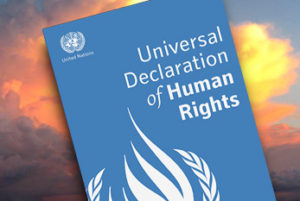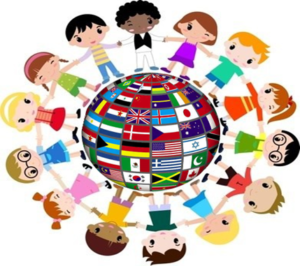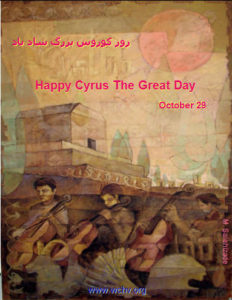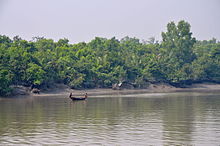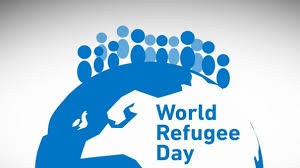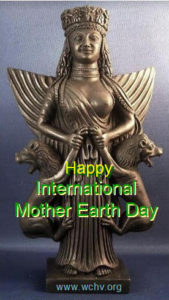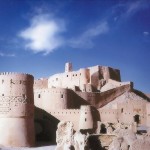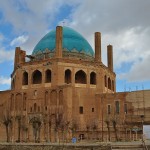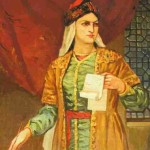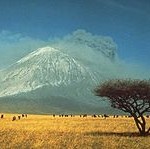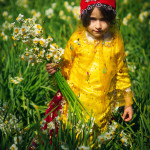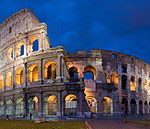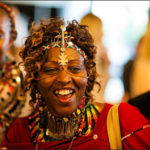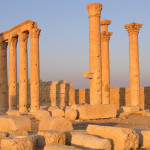By Amil Imani
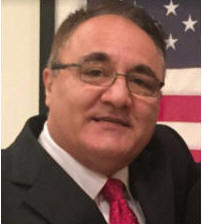 October 29th has been designated as the international day of Cyrus the Great. It is indeed fascinating that after 2500 years, people still remember this trailblazer King for his action as well as his deeds which was revolutionary during his time. Cyrus’s fame reached beyond his territory for his tolerance towards the countries and nations he subdued. It is cited time and again that he allowed people in his kingdom freedom of religion, freedom of worship and freedom to do as the please. After he entered the Babylon, he behaved respectfully towards Babylonian God Marduk. As one example, upon the conquest of Babylon itself, it’s recorded that he paid homage at the temple of the Babylonian god Marduk – thereby gaining the support of the Babylonian people and minimizing further bloodshed.
October 29th has been designated as the international day of Cyrus the Great. It is indeed fascinating that after 2500 years, people still remember this trailblazer King for his action as well as his deeds which was revolutionary during his time. Cyrus’s fame reached beyond his territory for his tolerance towards the countries and nations he subdued. It is cited time and again that he allowed people in his kingdom freedom of religion, freedom of worship and freedom to do as the please. After he entered the Babylon, he behaved respectfully towards Babylonian God Marduk. As one example, upon the conquest of Babylon itself, it’s recorded that he paid homage at the temple of the Babylonian god Marduk – thereby gaining the support of the Babylonian people and minimizing further bloodshed.
An illustration of the benevolent beliefs and practices launched by this unsurpassed
historical figure goes back to the landmark action of King Cyrus the Great of Persia. The
writer of the human rights charter, freed the “enslaved” Jews in Babylon and helped them
financially and by any means available at his deposal go to their Jerusalem, build their
temple, lead a peaceful life and worship their God without harming others or forcing them
to become Zoroastrian. The wise king realized instead of being demanding and risking rebellions, he learned how to compromise with his people, and bestowed upon them the basic human rights including freedom without losing control over his vast empire which eventually led to one of the greatest empires built to this day. It is precisely for this reason and his visionary leadership that his spiritual children celebrate his day with utmost pride.
Iranian civilization and its culture undoubtedly has marked a significant era in the history
of the world. In addition, to get a better picture of how the events ensued, we need to
briefly address Persia’s history and unravel some of its perplexing names and origins.
Some 2,500 years ago, the Persian Empire ascended to power and became an Aryan,
meaning the land of Iran. Cyrus the Great (Cyrus II), an Achaemenian King founded the
Persian Empire in the sixth century BCE by the unification of the two Aryan tribes, the
Medes and the Persians. In that medieval era, Persia controlled an empire that stretched
from Europe’s Balkan Peninsula in the West to India’s Indus Valley in the East. It was the
largest empire the world has ever known to that point.
Iran has always been a diverse empire. From the dawn of its inception to its current
existence. Diversity has always been its strength. They are the people who have given Iran its enduring strength and continuity throughout the ages. Those natives include Persians, Azaris, Kurds, Balochis, Turkmen, Gilakis, Mazandaranis, Lurs and more. For millennia, these Iranian patriots have all pledged their allegiance to Iran as an idea and a country that they all have shaped and contributed to its lofty culture and beauty. Iran has been a unified nation for thousands of years. I can attest that many Iranians consider themselves to be the spiritual children of Cyrus the Great and adherents to his Charter—the first Charter of Human Rights—that clearly proclaims equal rights and is worthy of the beliefs and practices of all people.
Because of what Cyrus did 2500 years ago, a truly groundbreaking action, Cyrus the Great belongs to all humanity who believe in tolerance towards one another.
We believe, being Iranian is defined by a state of mind, not by a place of residence.
Iranians are proud spiritual descendants of King Cyrus the Great, the author of the first
charter of human rights. Some of Cyrus’ children live in the patch of land called Iran. The
overwhelming majority—free humans with human beliefs—live in every country, city, and
village of the earth. These world-wide people, one and all, irrespective of nationality, color,
or creed are Iranians because they all adhere to the Cyrus Charter, they practice and
defend its lofty tenets, and, transfer this precious humanity’s treasure to the next
generation.
As Iranians, we are optimistic that very soon to take stock of our present condition and to
renew our resolve and to do all we must in our power to rescue Iran from the suffocating
quagmire that has stifled our people and return our nation to its rightful historic place: A
place in the vanguard of a civilized world where justice and liberty rule supreme for the
entirety of humanity.
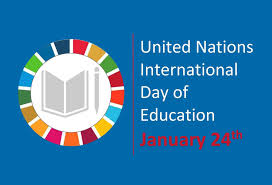 The world will celebrate the International Day of Education on 24 January 2020, a day proclaimed by the United Nations General Assembly to honor education and its entrality to human well-being and sustainable development. The 2020 celebration will position education and the learning it enables as humanity’s greatest renewable resource and reaffirm the role of education as a fundamental right, a public good and an enabler of the 2030 Agenda for Sustainable Development. It will frame ‘inclusive and equitable quality education and lifelong learning for all’ as a goal in and of itself, as well as a necessary means to accelerate progress to meet the targets of all 17 Sustainable Development Goals. As the UN organization mandated to lead on education in the 2030 Agenda, UNESCO will draw on its convening power and engage with education and development partners to celebrate the Day around the world by focusing on the many ways learning can empower people, preserve the planet, build shared prosperity and foster peace.The 2020 theme ‘Learning for people, planet, prosperity and peace’, highlights the integrated nature of education, its humanistic aims, as well as its centrality to our collective development ambitions. It also gives stakeholders and partners flexibility to tailor the celebration for diverse audiences, a variety of contexts and for priority themes.
The world will celebrate the International Day of Education on 24 January 2020, a day proclaimed by the United Nations General Assembly to honor education and its entrality to human well-being and sustainable development. The 2020 celebration will position education and the learning it enables as humanity’s greatest renewable resource and reaffirm the role of education as a fundamental right, a public good and an enabler of the 2030 Agenda for Sustainable Development. It will frame ‘inclusive and equitable quality education and lifelong learning for all’ as a goal in and of itself, as well as a necessary means to accelerate progress to meet the targets of all 17 Sustainable Development Goals. As the UN organization mandated to lead on education in the 2030 Agenda, UNESCO will draw on its convening power and engage with education and development partners to celebrate the Day around the world by focusing on the many ways learning can empower people, preserve the planet, build shared prosperity and foster peace.The 2020 theme ‘Learning for people, planet, prosperity and peace’, highlights the integrated nature of education, its humanistic aims, as well as its centrality to our collective development ambitions. It also gives stakeholders and partners flexibility to tailor the celebration for diverse audiences, a variety of contexts and for priority themes.

